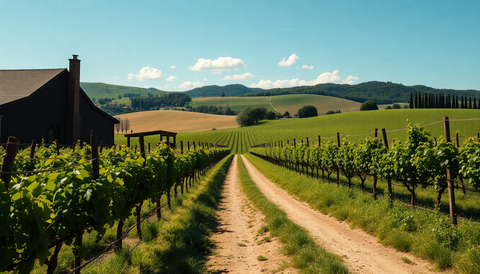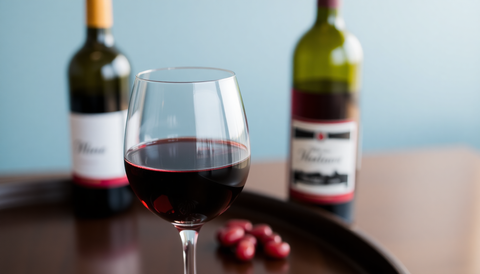Quick answer
A standard 750ml bottle of wine yields about 5 glasses when using a 150ml pour, which is a common restaurant standard. However the true number of glasses you get depends on several variables: pour size, bottle volume, alcohol strength, glass shape and the context of serving. This guide gives exact calculations, a full bottle-size chart, responsible drinking conversions, party-planning rules, pouring tips and answers to frequently asked questions for 2025.
Why 750ml became the global standard
The 750ml wine bottle is the modern international standard for most still wines. Its widespread use is the result of historical glass-blowing practices, shipping convenience and regulatory harmonization over the 20th century. While Champagne, fortified wines and historic formats vary, most table wines today use 750ml, making it a reliable baseline for planning and pricing.
How to calculate exact servings for any bottle
Use this simple formula to convert bottle volume to glasses:
- Number of glasses = bottle volume in millilitres ÷ pour size in millilitres
Examples with a 750ml bottle:
- 750 ÷ 100ml = 7.5 glasses
- 750 ÷ 125ml = 6 glasses
- 750 ÷ 150ml = 5 glasses
- 750 ÷ 175ml = 4.3 glasses
- 750 ÷ 250ml = 3 glasses
Round as appropriate for practical service. For tastings use 60–90ml pours; for dinner pours 125–150ml is common; for generous pours or big goblets you might see 200ml or more.
Bottle size chart: exact glasses per bottle using common pour sizes
The list below gives quick reference values. All numbers are approximate and rounded to one decimal where useful.
- Miniature 187ml (split): 1.2 glasses at 150ml, 1.5 at 125ml
- Half bottle 375ml: 2.5 glasses at 150ml, 3 at 125ml
- Standard 750ml: 5.0 glasses at 150ml, 6.0 at 125ml
- Magnum 1.5L: 10.0 glasses at 150ml
- Double magnum 3.0L: 20.0 glasses at 150ml
- Jeroboam 4.5L: 30.0 glasses at 150ml
- Imperial 6.0L: 40.0 glasses at 150ml
- Salmanazar 9.0L and larger: multiply the 750ml equivalents accordingly
To use any of these for different pours, divide the bottle volume by your chosen pour size.
Pour-size standards around the world
Pour sizes vary by culture, establishment type and legal regulation. Common norms include:
- Australia: 150ml is frequently used as the standard glass in restaurants
- United Kingdom: pubs and restaurants commonly serve 125ml and 175ml options
- United States: restaurants may list 5oz, 6oz or 8oz pours (roughly 148ml, 177ml, 237ml)
- Europe: tasting pours are often 100ml or 125ml; casual dinner pours 125–150ml
When planning for guests from different countries, assume 125–150ml to cover most expectations.
Converting wine volume to standard drinks or alcohol units
Understanding standard drinks is essential for responsible consumption and legal compliance. The reliable method uses bottle volume and alcohol-by-volume (ABV).
Formula to estimate grams of pure alcohol:
- grams of alcohol = bottle volume in ml × ABV percentage × 0.01 × 0.789
Use 0.789 as the density of ethanol (grams per millilitre). Then convert to your countryâs standard-drink size:
- United States: 1 standard drink ≈ 14 g alcohol
- Australia: 1 standard drink = 10 g alcohol
- United Kingdom: 1 unit = 8 g alcohol
Example calculations for a 750ml bottle:
- At 12% ABV: grams = 750 × 0.12 × 0.789 ≈ 71 g ⇒ US ≈ 5.1 drinks, AUS ≈ 7.1 drinks, UK ≈ 8.9 units
- At 13.5% ABV: grams ≈ 80 g ⇒ US ≈ 5.7 drinks, AUS ≈ 8.0 drinks, UK ≈ 10.0 units
- At 15% ABV: grams ≈ 89 g ⇒ US ≈ 6.4 drinks, AUS ≈ 8.9 drinks, UK ≈ 11.1 units
Remember: a bottle may contain more or fewer standard drinks depending on ABV; high-alcohol wines like fortified wine or some modern reds contain significantly more alcohol per bottle.
Practical pouring and service tips for consistent glasses
- Use measured pourers or jiggers until you develop trustable muscle memory. Common jigger sizes include 25ml, 35ml and 50ml.
- Invest in metered bottle pourers for events and restaurants; they reduce spillage and create consistent glass counts.
- Adopt the 1/3 glass rule for larger red-wine bowls: filling to about one third allows swirling without overflow and usually equals 125–150ml.
- For tastings, use smaller stemware and 60–90ml pours so guests can try multiple wines without overconsumption.
- Label bottles or create a tasting list with ABV and pour sizes to inform guests about alcohol intake.
How many bottles to buy: party planning formulas and examples
Plan using a simple formula:
- Bottles needed = (Number of guests × Expected glasses per guest) ÷ Glasses per bottle
Guideline scenarios:
- Casual cocktail party, 2 hours: plan 2–3 glasses per guest
- Seated dinner, 3-course, 3 hours: plan 2–4 glasses per guest depending on wine pairing
- Wine tasting, 6 wines, small pours: assume 6–8 90ml pours total per guest and plan accordingly
Example 1: 25 guests, 2 glasses each, 150ml pours → Bottles = (25 × 2) ÷ 5 = 10 bottles.
Example 2: 50 guests, cocktail party, 3 glasses each, include beer and spirits → If wine will supply half drinks: wine glasses = (50 × 3) × 0.5 = 75 glasses, bottles = 75 ÷ 5 = 15 bottles.
Always round up and add 10–15% for safety. Consider drink variety, duration and whether guests are heavy drinkers.
Serving wine in restaurants vs serving at home
Restaurants often use strict pour measures for cost control and consistency. House pours are pre-set and listed on menus so restaurants can predict revenue and inventory. At home, guests expect slightly more generous pours but you control the pace. For events, emulate restaurant measurements to stretch bottles while still giving guests a satisfying experience.
Glassware, perception and sensory considerations
Glass shape influences perceived portion size. Large-bowled glasses look less full with the same pour compared to smaller glasses. When tasting, narrow tulip-shaped glasses concentrate aromas so smaller volumes feel intense. For presentation and consistency:
- Choose glassware appropriate to your wine style and menu
- Use glass shapes that show pour levels clearly when you need portion control
- Serve sparkling wines in flutes for visual appeal but consider white wine stems for aroma when tasting
Leftover wine, storage and reuse
If a bottle is opened and not finished, preserve it by:
- Recorking and storing upright in the fridge for most whites and light reds; this slows oxidation
- Using vacuum pumps or inert gas wine preservers to extend freshness for several days
- Transferring leftover wine to a smaller container to reduce air contact
Generally, light whites can last 3–5 days refrigerated, fuller-bodied reds 2–4 days, and sparkling wines lose carbonation quickly unless sealed with a dedicated stopper.
Alcohol laws, standard drink labeling and why it matters
Many countries require standard drink information on wine labels or at point of sale. Knowing how many standard drinks are in a bottle helps hosts obey local laws and protect guests. For example, in Australia the legal sale price may be tied to the number of standard drinks; in other countries drink-driving rules mean you should inform guests of alcohol intake. Always check local regulations in 2025 before large events.
Common mistakes and how to avoid them
- Estimating by eye with large glasses: use measurement tools if you need exact counts.
- Assuming one bottle equals one person: base calculations on expected consumption, event length and beverage mix.
- Ignoring ABV: two bottles of the same volume with different ABV will supply different amounts of pure alcohol.
- Not allowing for preferences: provide a mix of red, white and rosé or sparkling so guests find something they like.
Advanced examples and scenarios
Scenario A – Wine tasting event for 40 guests with 6 wines and 90ml pours:
- Total pours per guest = 6 × 90ml = 540ml
- Bottles per guest = 540 ÷ 750 ≈ 0.72 bottles
- Bottles needed for 40 guests = 40 × 0.72 ≈ 29 bottles
Scenario B – Dinner for 12, two courses with a different wine for each course, 150ml pours, assume half the guests drink wine for both courses:
- Glasses needed = 12 guests × 2 wines × 0.5 drinking rate = 12 glasses
- Bottles = 12 ÷ 5 = 2.4 → buy 3 bottles each of the two wines
Pairing pour sizes with menu and pacing
Match pour size to meal pacing and food intensity:
- Heavy, rich foods: slightly smaller pours allow stronger wines to be tasted without overwhelming guests
- Long multi-course meals: smaller pours and more bottle variety keep pace without over-serving
- Informal gatherings: larger pours may be acceptable if alcohol intake is monitored and food is served
Eco and budget considerations when buying by the bottle
Buying magnums or larger format bottles can be more cost-effective and reduce cork waste for events, since larger bottles often bottle-age wines more gently and look impressive. However, large formats are harder to chill and open for small groups. Calculate cost per glass by dividing bottle price by expected glasses to help choose the most economical option.
FAQs
- Q: How many glasses in a bottle of bubbly? A: Same math applies. A 750ml bottle of sparkling yields about 5 glasses at 150ml, but sparkling is often poured in 100–125ml flutes for tastings or receptions so you may get 6–7 glasses.
- Q: Does ABV affect how many glasses I should serve? A: Yes. Higher ABV means each glass contains more alcohol, so consider lowering pour size or informing guests about the alcohol content.
- Q: How many bottles per person is typical for a wedding? A: For a wedding reception with cocktails and music assume 1 bottle per 2 guests for champagne toasts and 1 bottle per 2–3 guests for house wine over a 3–4 hour event, then adjust by beverage mix.
- Q: What is a tasting pour? A: Tasting pours are usually 30–90ml depending on the event; 60ml is common for formal tastings, 90ml for generous tastings.
Checklist: accurate pouring and planning
- Decide pour size before you buy
- Record ABV of selected wines for standard-drink calculations
- Choose appropriate glassware for perception and aroma
- Use measuring tools for large events
- Store open bottles properly and plan for leftovers
Final thoughts for 2025
Understanding how many glasses are in a bottle helps you plan smarter, pour consistently and keep guests safe. Whether you are buying for a dinner, a tasting or a large party, the core tools are the same: know your bottle volumes, set your pour sizes, account for ABV and round up to provide variety and buffers. With these calculations and practical tips, you can manage inventory, budget accurately and create better wine experiences in 2025.




Comments (0)
There are no comments for this article. Be the first one to leave a message!